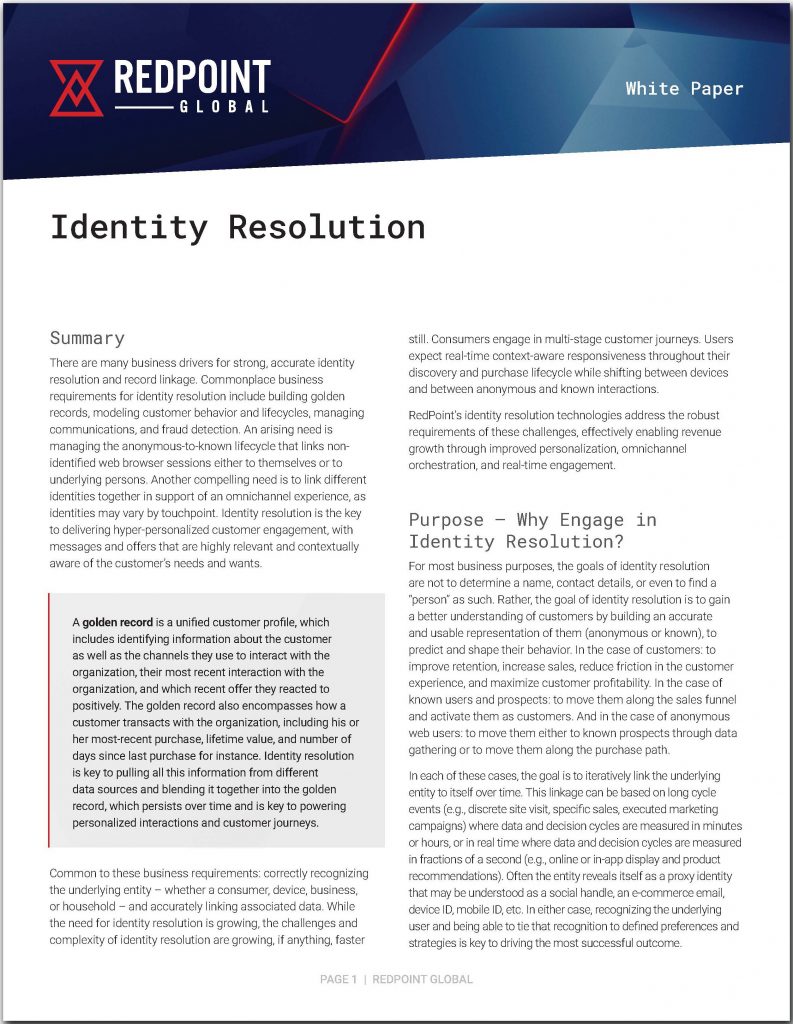 A PwC study revealed that consumers will pay more and share more data with companies that can provide a relevant, personal customer experience. In the study, a staggering 73 percent of consumers said that customer experience is a factor in their purchasing decisions, yet only 49 percent of U.S. consumers said that companies can provide a positive experience.
A PwC study revealed that consumers will pay more and share more data with companies that can provide a relevant, personal customer experience. In the study, a staggering 73 percent of consumers said that customer experience is a factor in their purchasing decisions, yet only 49 percent of U.S. consumers said that companies can provide a positive experience.
One reason for the discrepancy is that many brands fail to grasp the level of personalization customers have come to expect, or even understand the full spectrum for what’s possible. It’s not about addressing a customer by name in an email. Rather, it’s about recognizing a customer’s preferences, patterns, and behaviors in real time and shaping the customer journey with next-best action recommendations that are always relevant and in the right cadence at any touchpoint.
Identity resolution is required to close the experience gap. We explored many of the business drivers for identity resolution in a recent blog. Here, we’ll focus more on the challenges that advanced identity resolution presents.
While identity resolution or identity matching is sometimes misunderstood to mean finding a name, contact details, or even a person, its primary goal is to gain a better understanding of customers by reconciling different records for a customer across different engagement systems. For example, an email address and a digital certificate on a smartphone could be proxies for the same customer residing in different systems. Reconciling the two, along with any other identity proxy, helps build an anonymous-to-known record and provides marketers with the ability to better predict a customer’s behavior and begin to have an approximate measure of customer intent, resulting in the delivery of a more personal, relevant experience.
Marketers must resolve identity proxies across different systems while faced with an explosion of data sources and types – streaming, batch, structured, semi-structured, unstructured and third-party data – all of which are potential sources of customer data to be reconciled across different engagement systems. An obstacle to getting there is trying to process and match all customer data in the timeframe needed to be able to engage with a customer at their pace and speed.
A brand that can gauge positive social sentiment and link it via a device identifier to a recent e-commerce transaction can proactively shape a customer engagement in a segment-of-one approach – but only if it can do so according to the customer’s timetable. Data matching at the pace of the customer adds context to interactions, and without this context a brand may lose the opportunity to provide a next-best action in the proper cadence.
Identity Matching: It’s All About the Data
Today, there are countless ways for a customer to interact with a brand. An increasing number of touchpoints and devices has contributed to the dissolution of what was once a predictable customer journey into an indirect path-to-purchase without a defined beginning, middle, or end. As customers take charge of their journeys, they also expect real-time, context-aware responsiveness throughout their discovery and purchase lifecycle as they shift between devices and anonymous-to-known interactions.
Creating a 360-degree view of the customer across online and offline channels and all marketing, point of sale, and all enterprise interaction touchpoints is also known as a golden record. The golden record is an always-on, always-updating aggregation of an individual entity that continuously builds and maintains a record of linking information across an anonymous-to-known lifecycle. It provides marketers with the tools and capabilities needed for strong identity resolution, including advanced data matching, which adds an important element of context that is necessary for recommending relevant and personalized next-best actions.
Identity Resolution and Householding
Context is an important element in the evolution of householding, which identity resolution helps take to the next level. With more data, the complete customer profile that results from identity resolution does two things.
First, it expands the opportunity for marketers to tie identity proxies to the same physical address beyond such basic markers as a shipping address. Second, a complete profile allows for more targeted messaging. For instance, while a marketer can benefit from knowing that two customers live at the same address, benefits increase exponentially if identity resolution lets that marketer know who the head of household is, if they’re single or married, or how many children they have.
Understanding all purchasing dynamics within that household enables a marketer to provide a relevant, personalized customer experience to increase the customer lifetime value. A financial services company, for example, might correlate tax roll information with other customer data to make a determination if a residence is a single or multi-family unit and score the relevance of sending a re-finance offer to the head of household.
Solving the challenges and complexities of data matching and data latency are the keys to identity resolution, which is vital to keep pace with the customer across increasingly disjointed customer journeys. Matching customer records from a multitude of data sources across multiple systems of engagement are the key to providing the personalized experiences that today’s empowered customer demands.
RELATED ARTICLES
Identity Resolution and its Effect on CX
How Does Better Identity Resolution Help Banks Deliver a World-Class Customer Experience?
3 Top Identity Resolution Use Cases for Marketers
Be in-the-know with all the latest customer engagement, data management and Redpoint Global news by following us on LinkedIn, Twitter, and Facebook.

